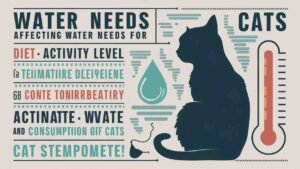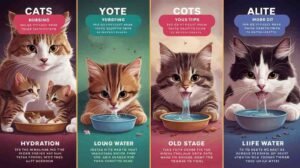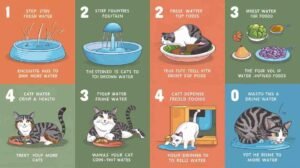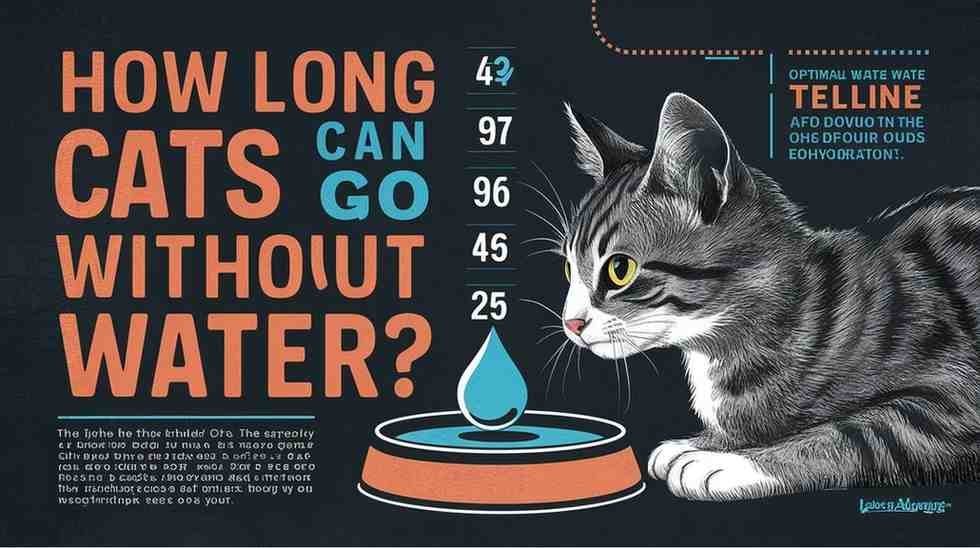Interest in our catlike companions frequently drives us to ponder their flexibility and endurance senses, including their capacity to do without water. Like every living animal, felines need water to flourish; however, they have influential flexibility.
Understanding how long felines can do without water is significant for dependable pet consideration. By investigating this subject, we can learn about the physiology and conduct of our darling pets.
In this way, how about we dive into the fascinating universe of feline hydration and uncover the mysteries behind their perseverance?
Felines commonly can do without water for around three to four days. Nonetheless, it’s pivotal to guarantee they approach new water daily to keep up with their well-being and hydration.
Screen your feline’s water consumption, particularly during sweltering climate or, on the other hand, assuming they have any medical problems, to forestall parchedness.
Grasping how long cats can go without water
Understanding their physiology is fundamental to how long felines can live without water. Felines are desert animals on the most basic level, relatives of wild felines that wandered parched scenes. Like this, they have advanced to proficiently moderate water. Their kidneys are exceptionally adjusted to thinking pee, limiting water misfortune.
Water: Imperative for Each Capability
Water isn’t simply a refreshment for felines; it’s crucial for each physical process. From processing to course to temperature guidelines, water plays an essential part. It greases up joints, supports supplement assimilation, and helps flush out poisons from the body. Without a sufficient water supply, a feline’s well-being can decay quickly.
Factors Affecting Water Needs

A few elements impact a feline’s water needs. Diet, well-being status, age, and natural circumstances all play a part. For instance, felines on a wet diet drink more water through their food than those on a dry diet. Medical problems like kidney sickness or diabetes can increase water necessities. Natural factors, such as temperature and mugginess, likewise influence hydration levels.
Hydration Tips for Feline Proprietors
Now that we comprehend the significance of water for felines, how about we investigate a few hints to guarantee our shaggy mates stay hydrated? First and foremost, admittance to spotless, new water should be given consistently. Felines demand consumers and may lean toward running water or water from a wellspring. Explore different avenues regarding different water sources to find what your cat likes best.
Perceiving Parchedness Signs
As dependable feline proprietors, perceiving the indications of parchedness in our pets is urgent. A few typical side effects incorporate dry mouth, indented eyes, dormancy, and loss of skin flexibility. If you suspect your feline has dried out, seek veterinary consideration immediately. Drying out can rapidly grow into a hazardous circumstance whenever left untreated.
Imaginative Ways of Empowering Hydration
A few felines can be fussy consumers. However, there are imaginative ways of empowering hydration. Consider adding water to your feline’s food to build their dampness admission. You can likewise take a stab at offering enhanced water or low-sodium stock as a delectable other option. Furthermore, putting resources into a feline wellspring can captivate your feline to drink more by impersonating the progression of a characteristic water source.
Counseling a Veterinarian
If all else fails, consistently counsel your veterinarian regarding your feline’s hydration needs. They can give customized appeals based on your feline’s age, well-being status, and way of life. Standard check-ups, including hydration levels, are critical for observing your feline’s general well-being. Your veterinarian can suggest dietary changes, hydration methodologies, or clinical medicines if fundamental, guaranteeing your feline stays blissful and hydrated.
Hydration in Various Life Stages

Little cat
Because of their fast development and advancement, little cats have higher water necessities than grown-up felines. Guarantee that little cats approach water consistently, assuming they are being weaned from their mom’s milk. Screen their water admission intently, as drying out can happen rapidly in youthful cats.
Grown-up Felines
Grown-up felines, by and large, have stable water necessities. However, factors like eating routine and movement level can impact their hydration needs. Give new water day to day and support customary drinking propensities. Wet food can add to their water admission, while dry food might require extra water utilization.
Senior Felines
As felines age, their kidneys are less productive at saving water. Senior felines are more inclined to dry out, so it’s significant to screen their water admission intently. Consider changing to a wet food diet to expand their dampness consumption. Senior felines may profit from ordinary check-ups to survey their hydration status and general well-being.
Step-by-step instructions on how to get Felines to drink more water?
Sound felines will normally self-manage their water utilization and drink as needed. Notwithstanding, felines that are persistently under-hydrated might be more inclined to constant kidney illness, stoutness, idiopathic cystitis (strange urinary side effects), or bladder stones. Therefore, pet guardians should consider expanding their felines’ hydration at home.
Taking care of cat all or, for the most part, wet food can assist your pet in staying better hydrated than felines that are taken care of kibble-just eating regimens. Kibble-eating felines are probably going to hydrate.
However, studies show that how much water they polish off may, in any case, need to catch up regarding the hydration contained in wet food-just weight control plans (1).
Yet, changing to wet food isn’t generally a dependable answer for parchedness issues. A few felines might disdain a wet-food diet, particularly if they were cared for for kibble their entire lives.
Furthermore, a few pet guardians might consider wet food excessively costly or poorly designed.

Another method for expanding hydration for kibble-eating felines is adding water to their kibble. Be that as it may, deciding how much your feline will endure is a fragile equilibrium.
For best outcomes, consistently start barely watering your feline’s kibble to perceive how they respond to it. If they still chow down, add more water to the kibble each time you feed them, as long as your feline keeps eating their food.
A few felines consider running water more engaging than a static water bowl, so you can increase your feline’s water consumption with a feline water fountain or a trickling spigot.
Notwithstanding, this is generally a singular inclination, so pet guardians should try different things and make various choices to see what their feline likes most (2).
The area and water bowl you use may likewise impact how much your feline beverages. Overall, felines favored drinking bowls with more modest breadth and got a kick out of the chance to drink from bowls in a room away from their food bowls (2).
Feline guardians can add modest quantities of fish or chicken stock to their feline’s water to make it sweeter-smelling and tempting.
Guaranteeing your feline stays appropriately hydrated is essential to keeping up with their general well-being and health. Regardless of whether your pet requires persuasion to meet its everyday water needs, these straightforward advances can assist you with getting your feline to hydrate and remain hydrated.
Simply recollect, if you are stressed that your feline isn’t drinking sufficient water or isn’t hydrated enough, ensure you talk with your veterinarian and take your feline in for a test immediately, assuming indications of parchedness are available.
Conclusion
While felines are strikingly versatile animals, they should only be done with water for a long time. It’s imperative to guarantee they approach new water daily, as drying out can prompt severe medical problems. Keep their water bowls spotless and filled so your catlike companion stays cheerful and hydrated.
FAQs(How Long Can Cats Go Without Water?)
What time does it expect for a cat to get dried out?
If a cat doesn’t hydrate, it can dry out within 24 to 48 hours. It depends upon various factors like age, prosperity, and environment. Thus, it’s urgent to guarantee your feline approaches new water consistently to forestall the lack of hydration.
How long can felines do without eating or drinking?
Felines can make do without nourishment for around 1 to fourteen days; however, without water, it’s an alternate story.
Without water, they can get dried out within several days. In any case, it’s fundamental to screen your feline’s well-being and conduct intently if they do without eating or drinking for a drawn-out period.
How frequently do felines require water?
Felines need water every day to remain hydrated and solid. They should regularly drink around 3.5 to 4.5 ounces of water per 5 pounds of body weight daily. Nonetheless, this can change due to elements like eating routine, action level, and natural circumstances. Guarantee your feline approaches clean water consistently to meet their hydration needs.
ALSO READ : CATS CARE
